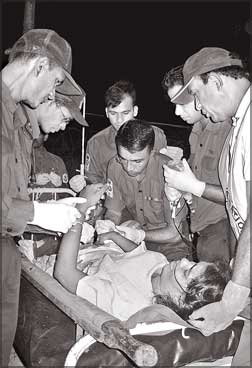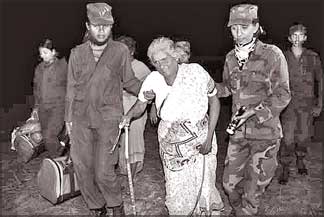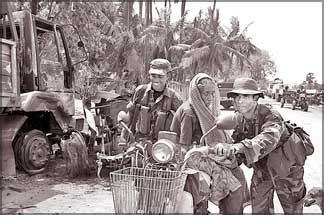LTTE assassinated over 100 democratically elected political leaders,
govt officials
Sandasen Marasinghe
The report ‘Humanitarian Operation Factual
Analysis July 2006-May 2009’ compiled by the Defence Ministry has it
that the LTTE which unleashed a brutal campaign of terror and violence
in Sri Lanka assassinated over one hundred democratically elected
political leaders and government officials from all ethnicities in Sri
Lanka as well as a Head of State of Sri Lanka and a former Prime
Minister of India.
Some extracts of the report:
Overview of the Humanitarian Operation
|

Navy personnel providing medical assistance to a woman
fleeing LTTE atrocities |
For three decades, the LTTE unleashed a brutal campaign of terror and
violence in Sri Lanka that resulted in the deaths of tens of thousands
of Sri Lankans of all ethnicities. Using a combination of terrorist
tactics and conventional forces, the LTTE carried out massacres of
innocent civilians, attacked economic targets and vital infrastructure
and created a fear psychosis that crippled everyday life for several
generations of Sri Lankans. The LTTE also assassinated over one hundred
democratically elected political leaders and government officials from
all ethnicities in Sri Lanka as well as the head of state of Sri Lanka
and a former Prime Minister of India.
|

Helping the sick and elderly who were held by the LTTE as
human shield |
In addition, the LTTE ceaselessly threatened and subjugated the
civilians living in the North and East, particularly in the areas it
dominated, recruiting young children as combatants, laying mines in
civilian areas, engaging in ethnic cleansing campaigns and denying the
people basic human rights and democratic freedoms. People in all parts
of Sri Lanka were terrorised by the LTTE and forced to endure a state of
unending fear and insecurity.
The LTTE has been recognised as one of the most ruthless and
sophisticated terrorist organisations in the world. Its use of
terrorist, guerrilla and conventional tactics through its semi
conventional fighting force, coupled with access to hundreds of millions
of dollars from criminal activities, voluntary contributions and the
extortion of individuals throughout the world, made the LTTE a
formidable foe that repeatedly eluded military defeat.
Throughout the protracted armed conflict with the LTTE, the
Government of Sri Lanka repeatedly tried to engage the LTTE in peace
talks with the goal of reaching a peaceful negotiated settlement. In two
instances foreign governments also assisted in this effort: in 1987, the
Governments of India and Sri Lanka signed the Indo-Lanka Accord, which
led to the presence of an Indian Peace Keeping Force (IPKF) in Sri Lanka
for two years, and in 2002, a peace process was facilitated by Norway.
During each attempt for a negotiated settlement, the LTTE rebuffed the
opportunity for peace and used the cessation of hostilities during talks
to regroup, rearm and strengthen its military capabilities.
|

Security Forces personnel helping an elderly woman in
distress |
During the ceasefire that accompanied the last peace process, the
LTTE closed a vital sluice gate at Mavil Aru in July 2006, posing a dire
threat to civilians of all ethnicities in the Trincomalee District. This
was immediately followed by a well-planned attack by the LTTE on several
fronts to take possession of the strategic Trincomalee Harbour and the
surrounding areas. Given the immediate threat to civilian lives, the
history of atrocities inflicted on its people and the LTTE’s repeated
violations of the ceasefire agreement, Sri Lanka had no resort but to
launch a Humanitarian Operation to liberate the people of the East and
North from LTTE control and free all Sri Lankans from the LTTE’s terror.
As this Humanitarian Operation progressed in Sri Lanka’s favour, an
increasingly isolated LTTE leadership surrounded itself with a human
shield of thousands of civilians in a brutal attempt at
self-preservation. The LTTE forcibly detained these civilians and kept
them hostage through violent means, and deliberately endangered their
lives by blurring the distinction between combatants and civilians, and
by using protected civilian sites for military activity.
Acutely aware of the atrocities committed by the LTTE, its scale and
sophistication, and the clear and present danger to thousands of
civilians trapped by the LTTE, the Government of Sri Lanka had a
responsibility and a duty to defeat the LTTE and liberate the civilians
trapped in its clutches. Security Forces acted with the force necessary
to accomplish this task and proportionate to the threat they faced.
The government of Sri Lanka made every effort to protect civilians in
the conflict zone through the creation of Safe Corridors and No Fire
Zones, and by adhering to a “Zero Civilian casualty” policy that had
been conveyed to all troops through repeated training and operational
orders.
Sri Lanka also took a proactive and extensive role in delivering
humanitarian assistance to these civilians before, during and after the
fighting. Despite the clear intent of the Government of Sri Lanka and
the numerous precautions taken, it was impossible in a battle of this
magnitude, against a ruthless opponent actively endangering civilians,
for civilian casualties to be avoided.
To be continued
|



